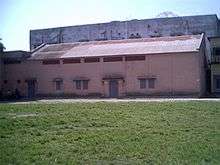Siliguri Boys High School
Siliguri Boys' High School is a school for boys in Siliguri, West Bengal, India.
History
The school was established in 1898 as a Middle Bengali School and upgraded to a High Bengali School in 1918 with six students in standard VIII. However, 1918 is considered as the year of establishment of Siliguri Boys’ High School though it had started its function 20 years earlier.
After independence the school was converted to a multipurpose high school in 1957, with the introduction of the three streams of Science, Commerce and Humanities. This was the first multipurpose school of the region. Later the medium of instruction was shifted to Bengali from English.
Secretary
The first secretary of the school was Rai Saheb Surendranath Bhattacharya, from 1904 to 1917. The school was upgraded to a high school in 1918 and he was there as secretary till August 1936 and then as the Vice-President till 1940. Surendranath Bhattacharya came to Siliguri from Burdwan in 1903, he was the son-in-law of Kaliprasanna Bhattacharya.
The office of the secretary was followed by Kali Kinkar Singha, Birendranath Sarkar, Swadesh Ranjan Sarkar, etc. The present secretary is Sri Madhu Sudan Chakraborty. The school has a dress code of a white shirt and blue pants. The dress code is said to symbolise the Indian flag's middle position.
Head Master's office
(1918–2011)
- Khitish Chandra Bhattacharya
- Anadinath Mukherjee
- Karuna Krishna Sarkar
- Sudhindranath Raha
- Sachindra Mohan Sarkar (1927–63)
- Khestra Nath Choudhury
- Ramanath Chakraborty
- Monoranjan Choudhury
- Narayan Chandra Saha
- Anil Ghosh
- Chandan Das
One of the most prominent head masters the school had was Sri. Sachindra Mohan Sarkar. His 36 years tenure is considered as the golden era of the school. During his term the school was upgraded to a multipurpose school. Sanchindra Mohan Sarkar worked as an assistant teacher in Nafar Chandra Vidyalaya in Natudaha in the district of Nadia before he joined the school.
Affiliation
The school is affiliated to the West Bengal Board of Secondary Education and the West Bengal Council of Higher Secondary Education.
Building

The school was housed in a hut made of thatched paddy roof, wooden floor, plinth on logs and bamboo doors. It stood where the present Tathya Kendra stands. In 1922 the school was burnt to ashes.
A 2.29 acres (9,300 m2) of land was demarcated in the Railway Survey Map of 1877 near the Terminal Rail Station (now Siliguri Town Station) where the school stands today. In the early years the classes were held in two buildings. One with 18 ft (5.5 m) x 80 ft with a 6 ft (1.8 m) veranda and the other was 56 ft (17 m) x 17 ft (5.2 m) with a 5 ft (1.5 m) verandah. Later a 18 ft (5.5 m) x 15 ft concrete office and library were made followed by a bigger headmaster’s sitting room and lumber.
Behind this building there were two more rooms used as a hostel for the Hindu and Muslim students. Before this hostel was made the Hindu hostel was approximately 1 km far off on the Hill Cart Road, where the present Layak Bhawan stands.
Now the school has a three-storey building with an auditorium, staff rooms, Physics, Chemistry, Biology and Geography laboratories.
Notable alumni
- Charu Majumdar, founding leader of the Naxalbari Movement
- Anandamoy Bhattacharjee, former Chief Justice of the Calcutta High Court and the Bombay High Court
- Anup Deb, former Chief Justice of Sikkim High Court
- Prof. Asru Kumar Sikder, professor of Bengali language and literature.
- Dr. Biplab Bhawal, scientist (Physics) at Caltech, USA. Editor-in-chief of 2Physics.com
- Goutam Deb, North Bengal Development Minister
- Ashok Bhattacharya, former Urban Development Minister of West Bengal
- Wriddhiman Saha, wicket-keeper, Indian Cricket Team
- Soumyajit Ghosh, youngest Olympian of India in London 2012 and National Champion in table tennis
Siliguri Boys' High School Alumni Association
The ex-students of the school have formed an Alumni Association to provide support to the school. During the first year, the association organised projects including organising ADDA on the eve of Saraswati Puja, and felicitating successful students of the board examination (Class X and XII). The new committee was formed so that it gave representation from the different age groups of the alumni. Thus recent passed out students were taken into it.
External links
| Wikimedia Commons has media related to Siliguri Boys' High School. |
- http://sbhssiliguri.in Official website
- http://sbhsalumni.in/ Official website of the Alumni Association